SHAMANISM
- Gillian Godtfredsen & Melinda Merunada, The Paradigm Academy
Shamanism is a spiritual and medical practice based upon the belief that all healing includes a spiritual dimension. Shamans enter altered states of consciousness to communicate with other realms of reality. The shaman's journey is to help the person or community to rediscover their connection to nature and spirit.
Shamanism is a tradition dating back thousands of years. Traditionally, the shaman is responsible for the health of the individual as well as the community. This is a physical, mental, emotional, and spiritual balance. Shamans are the ritual leader, herbalist, and mediator between the community and the spirit world. The spiritual healing methods of shamanism are now receiving increased and significant attention in our culture.
Many believe that the teachings of shamanism are universal because they are from a source which is available to all beings who are open to the flow of information, and those who journey inward will eventually gain universal knowledge and wisdom.
The Shaman
 To understand the practice of a shaman, it is important to understand some of the fundamental concepts of what shamanism is. It is a specific set of methodologies for accessing the spirit or energy field of anything or anyone. The shaman heals by working with unseen/inner/spiritual reality to create changes, which in turn creates changes in physical everyday reality.
To understand the practice of a shaman, it is important to understand some of the fundamental concepts of what shamanism is. It is a specific set of methodologies for accessing the spirit or energy field of anything or anyone. The shaman heals by working with unseen/inner/spiritual reality to create changes, which in turn creates changes in physical everyday reality.
What distinguishes the shaman from other types of healers is the journeying to the spirit world, by way of the shamanic state of consciousness for the purpose of obtaining information. The information is used for insight and/or healing.
The Essential Perspective of the Shaman
- Everything is alive. Everything has spirit and awareness
- Energy and matter are the same
- Everything is vibration
- Everything that exists is an energy system within a greater energy system
- Everything that exists is connected to everything else in a web of energy or life
- Unseen/inner/spiritual reality affects visible reality
Working within this system of perceptions, the shaman strives to create balance and harmony of the spirit. This can be applied to the individual or the community.
The Roots of Shamanism
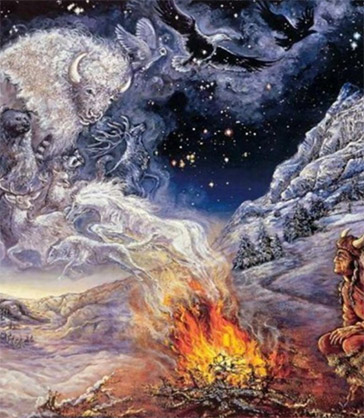 The word “shamanism” stems from the language of the Siberian Tungus tribe. Central to all shamanistic practice is the concept of seeing the energy behind form. Common to all Shamanic practices are the tools; the drum, bells, rattles and the journey to the 3 worlds:
The word “shamanism” stems from the language of the Siberian Tungus tribe. Central to all shamanistic practice is the concept of seeing the energy behind form. Common to all Shamanic practices are the tools; the drum, bells, rattles and the journey to the 3 worlds:
The Lower World of energy, raw and dynamic potential. A world of animal, plant and echoes of matter's origin. Journeys to the Lower World are often associated with animal guides, power animals, discussions with trees, forests, mountain ranges, continents etc.
The Middle World is the energetic and observational analogue of our physical
world. Remote viewing, seeing, visiting and projections are all conducted in the Middle World.
The Upper World is the realm of Spirit. Journeys to the Upper World often take place in contact with spirit guides, ancestors and sentient spirits.
The Axis Mundi, or World Tree is a metaphor for the 3 worlds, with the crown representing the Upper, ground representing our physical Middle and the root system representing the Lower worlds.
There are many teachers and practitioners of shamanism today. There is some confusion and dispute as to the use of the word “shaman” to describe the great variety of cultural healing traditions. One of the most prominent writers and teachers is Michael Harner, author of “The Way Of The Shaman”. Others are Malidoma Some, who teaches Dagara wisdom and Don Miguel Ruiz, author of “The Four Agreements,”. Other important names are Mircea Eliade, Carlos Castenada, Alberto Villoldo, Roger Walsh, Kenneth Meadows, Lynn Andrews, Angeles Arrien, Stanley Krippner, Sandra Ingerman and Hank Wesselman.
In his book The World of Shamanism – New Views of an Ancient Tradition Professor of Psychiatry, Philosophy and Anthropology Roger Walsh MD, PhD describes shamanism as “the world's most enduring healing and religious tradition―in the light of modern medicine, psychology, neuroscience, consciousness disciplines, and religious studies.”
The roots of shamanism can be seen in early, nature based cultures all over the planet, just about any place where people still live close to nature. Shamanism is considered by many to be the oldest spiritual system or religion ever practiced. In The Way Of The Shaman, Harner writes maintains there is evidence of shamanistic practices dating as far back as the Neolithic period and “Shamanism represents the most widespread and ancient methodological system of mind-body healing known to humanity. Archaeological and methodological evidence suggests that shamanic methods are at least twenty or thirty thousand years old.”
In European traditions, this is seen in the Nature religions of the Celts and Druids. In Asia, the Tibetans, the Tuvans, the Mongols, and the Manchu peoples all practiced forms of shamanic spirituality. In Hawaii, the Kahunas are masters of channeling energy, and their sacred practices have become highly secretive in order to be safely continued. The Kahunas are still a very vital part of Hawaiian culture.
Shamanism has been practiced widely throughout South America for thousands of years. The Q’ero people of the Andean mountains still live a primitive and isolated lifestyle and have thus preserved more of their original culture than other South American peoples. They, and the living spirit of ancient wisdom is still thriving there.
Throughout Central and South America there many people us a special drink, commonly called Ayahuasca, but also known as “Grandmother”, “the remedy” or simply “The Teacher.” Evidence of this medicine’s use goes back over 2,500 years. Ayahuasca is a Qechuan word, aya meaning spirit or ancestor, and huasca meaning vine, and so this magical plant is called vine of the souls. Those who drink it are said to have the ability to communicate with spirits, and many believe that the plant itself communicates and can teach many things, and reveal things which are hidden.
Westerners are taught to perceive primarily through their five senses and to rely mostly on the sense of sight. If we can’t weigh it, count it or measure it – it doesn’t exist. Perceptually this confines us to linear time. Unable to see the world energetically and multidimensionally and step beyond linear time.
Some people though can glimpse dimensions beyond ordinary perception - experiences the rational mind prefers to deny or minimize. For some these experiences occur during meditation, through the discovery of portals or gateways to a higher level of consciousness; or through inspired writing, music, dancing or artwork.
Tuvan
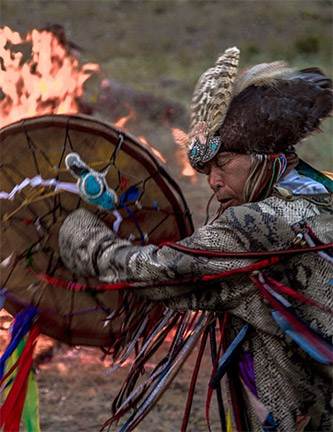 In the Tuvan culture of Southern Siberia, shamans have always played an important role in the community. The people of Tuva hold the perception of the natural world as being alive with spiritual energies, and they strive to maintain a harmonious relationship with their environment. Here in this fluid and mystical world, all of the seen world is imbued with a stream of consciousness from the unseen world. Here spirit plays out great adventures and dramas, and the seen and the unseen are woven together in an unbroken fabric called the play of life. Everywhere are sacred places of power, often marked by piles of stones left as offerings to the spirits. Passing travellers add stones with their own prayers. Healing work involves soul retrieval, and soul work around birth, death, and other life transitions.
In the Tuvan culture of Southern Siberia, shamans have always played an important role in the community. The people of Tuva hold the perception of the natural world as being alive with spiritual energies, and they strive to maintain a harmonious relationship with their environment. Here in this fluid and mystical world, all of the seen world is imbued with a stream of consciousness from the unseen world. Here spirit plays out great adventures and dramas, and the seen and the unseen are woven together in an unbroken fabric called the play of life. Everywhere are sacred places of power, often marked by piles of stones left as offerings to the spirits. Passing travellers add stones with their own prayers. Healing work involves soul retrieval, and soul work around birth, death, and other life transitions.
Often, though not always, a shaman inherits the task. Telltale signs are observed in a child by the family, e.g. past life memories, vivid dreams, speaking different languages, accurate predictions of future happenings, spending much time alone in nature, communicating with animals and speaking spontaneous poetic verse. These are seen as initial contacts by spirits wishing to work with the person.
The final sign preceding shamanic initiation is the “shaman’s illness» representing the invasion of the person by the spirit of a shaman. Common manifestations are dizziness, fainting, memory loss, convulsions, ringing in the ears, dramatic change in personality, fever, delirium, and excessive sleeping. When these symptoms present, the local shaman is called in to diagnose and confirm that the person had indeed been inflicted with the shaman’s illness. Though this is considered an honour, it is not always welcome, since it represents a great responsibility, and often a worrying ordeal for the budding shaman. Once the diagnosis is confirmed, if the person accepts the call of the spirits and begins the shaman’s journey, with the guidance of the local shaman, the illness will most often quickly subside. If the call is ignored or rejected, the illness may intensify, and death may occur.
With the commencement of training, the initiate would require the tools of the trade. This includes the customary tunic, decorated with long ribbons representing spirit helpers, bells and other sacred metallic objects – all for the purpose of inducing trance and sound effects for ritual and journey; a feathered headdress to facilitate flight and spirit contact. Last but not least the all-important drum, or “shaman’s horse,” used to produce the trance inducing rhythm which facilitates the shamans “ride to the other side.” The Tuvan shaman also uses his voice as a tool. During ritual, the shaman often sings, chants, and recites epic verse, carrying the oral tradition of the culture in this way.
Tuvans view all sound as expressions of spirit, especially sounds in nature, such as an echo, a bird’s call, whistling wind, and thunder. These vibratory resonances are expressions of specific spirit energies, often sent as messages.
Another aspect of Tuvan culture is a great emphasis on the stars and astrology, with special importance given to the Bear constellation, the place of origin of the people in Tuvan mythology. The shaman’s astrological chart is carefully examined early on in his/her life, and he/she is trained in star wisdom. He/she sets up horoscopes for people commonly in the beginning of the year, along with an annual house blessing and purification.
Tibetan
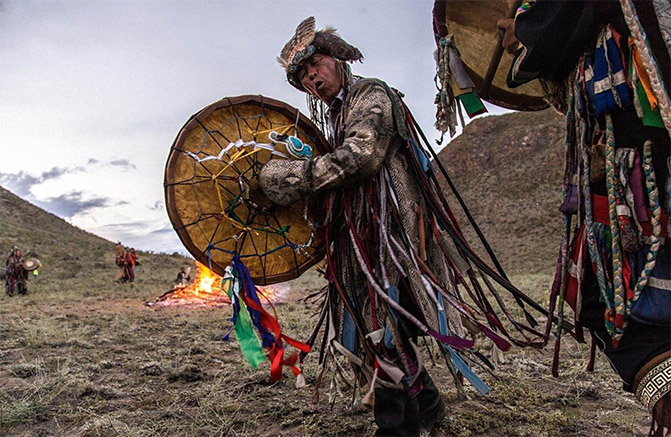 The root of the practice of shamanism by the people of Siberia, including the Tuvans, is most likely Asian shamanism. The Bon Shamans of Tibet understand reality as consisting of a three tiered universe, connected by a ladder of rope. This is similar to the mythology and beliefs in root cultures all over the world, though quite often, it is a tree which connects the worlds, the roots being in the lower world, the trunk being in the middle world, and the branches, leaves and fruit being in the upper world.
The root of the practice of shamanism by the people of Siberia, including the Tuvans, is most likely Asian shamanism. The Bon Shamans of Tibet understand reality as consisting of a three tiered universe, connected by a ladder of rope. This is similar to the mythology and beliefs in root cultures all over the world, though quite often, it is a tree which connects the worlds, the roots being in the lower world, the trunk being in the middle world, and the branches, leaves and fruit being in the upper world.
The universal tree growing at the center of the universe, connecting the three levels of reality is common throughout Asian shamanism, and is seen as well in European shamanism. A very important responsibility of the Bon shamans of Tibet is to escort the dead through the astral worlds to return safely to the upper worlds. The Tibetan Book of the Dead describes the journey in which the Tibetan lama leads the dying soul through the bardo worlds to the clear light, or higher world, the source of life. This Tibetan Buddhist practice strongly parallels that of shamanic practices of escorting the dead on their final journey.
Common to all shamanic cultures is the work of helping these lost souls to find their way, as they often attach to living people, causing disease and other unwanted manifestations.
In Tantric Buddhism, perfected by the Tibetans as the “Diamond Vehicle,” a direct route to ascension, there are strong parallels with the shamanistic worldview. The central rope or tree is the spine, with the chakras, the levels or worlds to be traveled, and the kundalini awakening and movement upward representative of the shamanic journey. Here we can see the connections with the Jewish Qabalah as well, the tree of life with its spheres, or realms to be travelled by the initiate.
Hawaiian
 Hawaiian spirituality has its roots in ancient Polynesia. The ancestors of the people of Hawaii were Polynesian explorers, considered to be the greatest explorers and navigators of the ancient world. They came to the Hawaiian islands some 2000 years ago by boat, guided by Makani, the life-giving spirit of the air, in what we call the trade winds. Wind is the source of life in Polynesian spirituality, associated with the breath, also called Ha. Aloha means “with breath,” and is commonly translated as “love.”
Hawaiian spirituality has its roots in ancient Polynesia. The ancestors of the people of Hawaii were Polynesian explorers, considered to be the greatest explorers and navigators of the ancient world. They came to the Hawaiian islands some 2000 years ago by boat, guided by Makani, the life-giving spirit of the air, in what we call the trade winds. Wind is the source of life in Polynesian spirituality, associated with the breath, also called Ha. Aloha means “with breath,” and is commonly translated as “love.”
Kahuna is a Hawaiian term used to indicate a person who is a master of their craft, usually someone who embodies knowledge of the old ways, whether it be canoe building, playing music, hula dancing, healing, soul work, or any other valued skill passed down through generations. The chanting, dancing, and drumming, which is central to Hawaiian spirituality, is an expression of the intention and desire to blend energy with, and express oneness with, the natural world, the wind, the rhythm of the ocean waves, Pele's voice in the rumbling volcano, and the sounds of birds and other animals.
The root meaning of Aloha is very similar to “Namaste," a Sanskrit word translated as I bow before the god within you. Alo means “in the presence of," and ha means “breath of life,” so an aloha greeting acknowledges the presence of the creator within both people, and the oneness and love that exists within and between them.
According to Serge Kahili, a Hawaiian healer practicing Huna, a modern healing system based on ancient Hawaiian spirituality, there are seven basic principles or assumptions of Huna, and they are:
- The world is what you think it is
- There are no limits
- Energy flows where attention goes
- Now is the moment of power
- To love is to be happy with
- All power comes from within
- Effectiveness is the measure of truth
Kahili also describes 4 different dimensions or levels of reality which are mastered by the practitioner in order to effectively help others. These are:
- Everything is objective (scientific reality)
- Everything is subjective (psychic reality)
- Everything is symbolic (shamanic reality)
- Everything is holistic (mystical reality)
In Huna philosophy the secret which has been given to humanity over and over again is: “Bless everyone and everything that represents what you want!” A very simple, yet revolutionary and infinitely powerful idea. Kahili gives 3 reasons why this is highly effective.
- Positive focus of the mind generates positive creative force from the universe
- When your energy moves outward you become open to more power flowing through you
- When you bless for the benefit of others you tend to bypass subconscious fears about what you want, yet the act of blessing and energizing for the benefit of another automatically increases the same good in your life, for you are affirming the energy of this good thing, which effectively increases it, because Energy flows where attention goes.
African
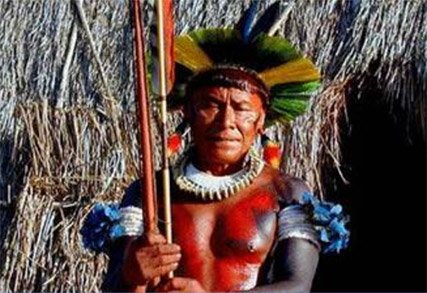 The Dagara, a tribe indigenous to Burkina Fosa in West Africa, believe that every child is born with a life purpose. In the village, that purpose is revealed by the elders before the child is born through a process of divination. The community then supports each person throughout life in order to keep that person on a clear path, aligned with his or her purpose. Malidoma Some has several degrees from universities in France, and has written several books, including Healing Wisdom Of Africa, Of Water And Spirit, and Ritual: Power, Healing, And Community (1998).
The Dagara, a tribe indigenous to Burkina Fosa in West Africa, believe that every child is born with a life purpose. In the village, that purpose is revealed by the elders before the child is born through a process of divination. The community then supports each person throughout life in order to keep that person on a clear path, aligned with his or her purpose. Malidoma Some has several degrees from universities in France, and has written several books, including Healing Wisdom Of Africa, Of Water And Spirit, and Ritual: Power, Healing, And Community (1998).
The power and importance of ritual is central to the teachings of Malidoma: there is no distinction between everyday life and spirituality. All activities are approached with intention and care. To comprehend it you have to get out of the economic thinking that is common to capitalistic cultures.
Malidoma talks about a “longing for home”, by this he is referring to the ways of life that were banished in the name of “progress.” The new tribal order that he sees as awakening consists of people all over the planet who are realizing that they can cycle back around, bringing the time-tested natural ways back into conscious reality and in their lives. He maintains “people from many places, though isolated by the limitations of modern culture, are awakening to their deeper nature.”
Australian Aboriginee
 The Australian Aboriginees are well known for their shamanistic practices, though white people have difficulty in learning their practices because they have not been able to witness such things unless they have become part of the tribe and have been sworn to secrecy. In Aboriginee tribes, outsiders don’t even have a name until it is given to them. One thing that is known about Aborigine belief systems is that they believe that life is a dream of the soul, and that it is all illusion. They know they are dreaming themselves as humans. Books and internet resources re minimal because, for the most part, they have kept their practices a secret. Needless to say they should be mentioned in any learnings on shamanism, for they are, perhaps, the only practitioners who are still somewhat untouched by the civilized world and are happy to remain so. Their shamanistic practices are still quite pure and unadulterated.
The Australian Aboriginees are well known for their shamanistic practices, though white people have difficulty in learning their practices because they have not been able to witness such things unless they have become part of the tribe and have been sworn to secrecy. In Aboriginee tribes, outsiders don’t even have a name until it is given to them. One thing that is known about Aborigine belief systems is that they believe that life is a dream of the soul, and that it is all illusion. They know they are dreaming themselves as humans. Books and internet resources re minimal because, for the most part, they have kept their practices a secret. Needless to say they should be mentioned in any learnings on shamanism, for they are, perhaps, the only practitioners who are still somewhat untouched by the civilized world and are happy to remain so. Their shamanistic practices are still quite pure and unadulterated.
American Indian
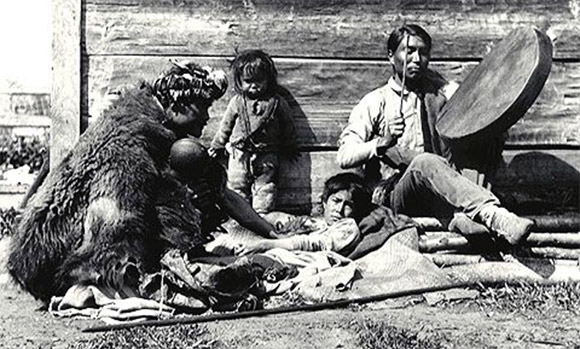 The practice of Shamanism has regained power and prestige in recent times. Traditionally, a shaman would receive powers through bloodlines, or be chosen by spirit entities, often unwillingly. Today, many people train to be shamanic practitioners, yet most believe that traditional shamans are much more powerful than one who “chooses” to pursue the path.
The practice of Shamanism has regained power and prestige in recent times. Traditionally, a shaman would receive powers through bloodlines, or be chosen by spirit entities, often unwillingly. Today, many people train to be shamanic practitioners, yet most believe that traditional shamans are much more powerful than one who “chooses” to pursue the path.
Some people wonder if the experience of shamanic consciousness or flight makes a person a shaman. Generally speaking, experienced practitioners would say no. A shaman is much more than someone who has a shamanic experience. First, he or she is a trained initiate through years of careful mentoring before functioning as a shaman. The relationship is not just a casual acquaintance with; there is a high degree of mastery involved. Finally, a shaman is a link or bridge between this world and the next. This is a sacred trust and a service to the community. Sometimes a community that a shaman serves in is rather small. In other instances it may be an entire nation – all depending on social and cultural factors.
As humanity evolves and becomes more enlightened, a fast growing number of people in the Western world are becoming aware of and practice altered states of consciousness and spiritual truths. The ancient and timeless teachings and practices of shamanism can greatly accelerate spiritual growth and everyday wisdom as the realization of the underlying connectedness of all life is acknowledged.
REFERENCES:
Eliade, M. (1964). Shamanism: Archaic Techniques of Ecstasy. Paris: Bollingen Foundation.
Harner, M. (2011). The Way of The Shaman. New York: Harper and Row.
Ingerman, S. (2004). Shamanic Journeying: a beginner ́s guide. Boulder, CO: Sounds True.
Ingerman, S. (2015) Walking in light: the everyday empowerment of shamanic life. Boulder, CO: Sounds True.
Pinchbeck, D. (2002). Breaking Open the Head: A Psychedelic Journey into The Heart of Shamanism. New York: Random House.
Polich, J. B. (2001) Return of The Children of Light. Rochester, VT: Bear & Co.
Ruiz, don M. (1993). The Four Agreements: A Practical Guide to Personal Freedom. San Rafael, CA: AmberAllen Publishing.
Ruiz, don M. (2004). The Voice of Knowledge: A Toltec Wisdom Book. San Rafael, CA: Amber Allen Publishing.
Rysdyk, E.C. & Ingerman, S. (2013). Spirit walking: a course in shamanic power. San Francisco: Weiser Books.
Some’, M. P. (1995). Of Water and The Spirit: Ritual, Magic and Initiation in The Life of An African Shaman. New York: Penguin Putnam.
Some’, M. P. (1993). Ritual: Power, Healing and Community. New York: Penguin Putnam. Some’, M. P. (1997). The Healing Wisdom of Africa: Finding Life Purpose Through the Nature, Ritual, And Community. NY: Penguin Putnam.
Villoldo, A. (2000). Shaman, Healer, Sage: How to Heal Yourself and Others with The Energy Medicine of The America. NY: Harmony Books.
Villoldo, A. (2005). Mending the Past and Healing the Future with Soul Retrieval. Carlsbad CA: Hay House.
Copyright © 1995-2019 The Paradigm Academy


